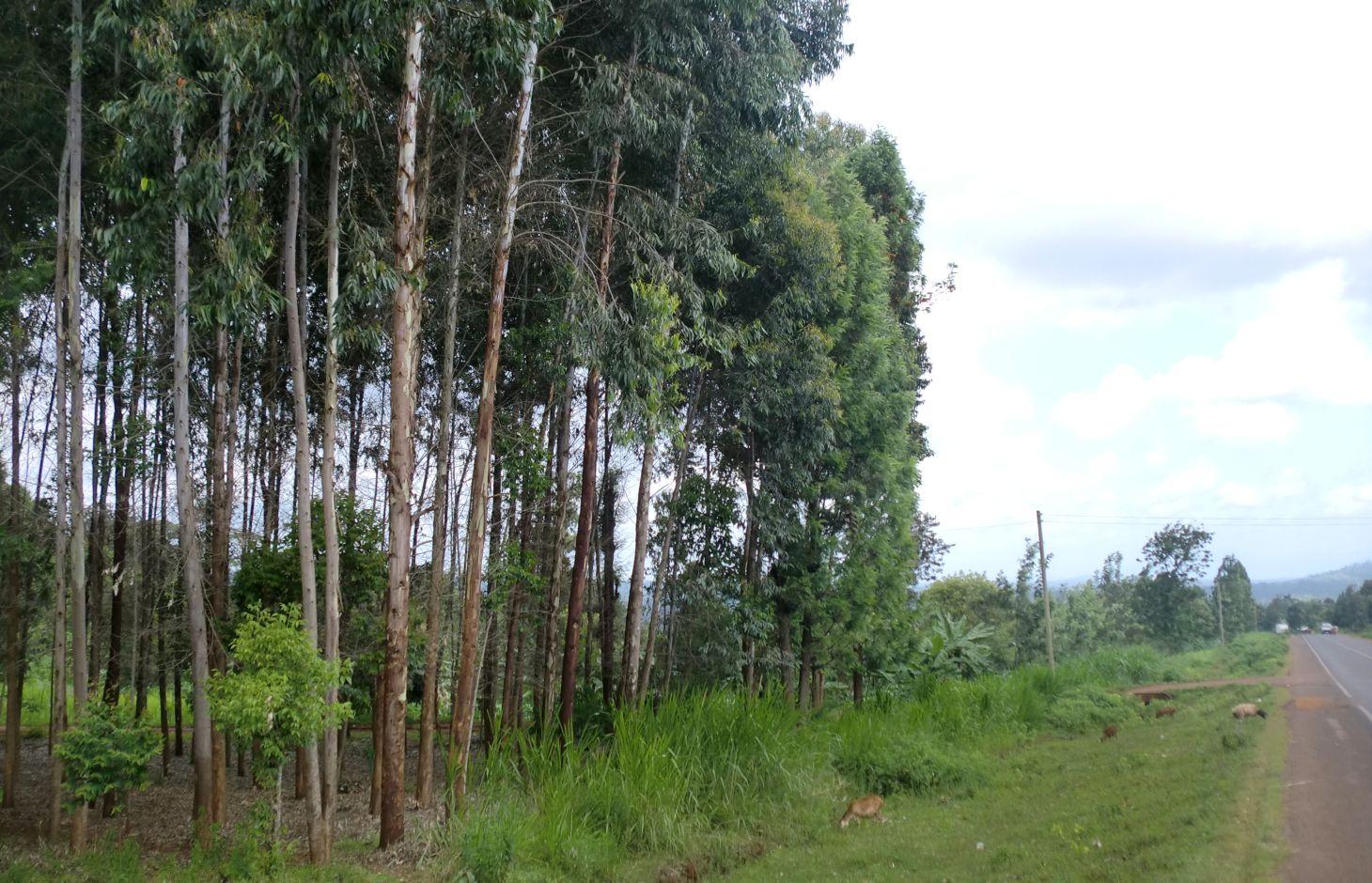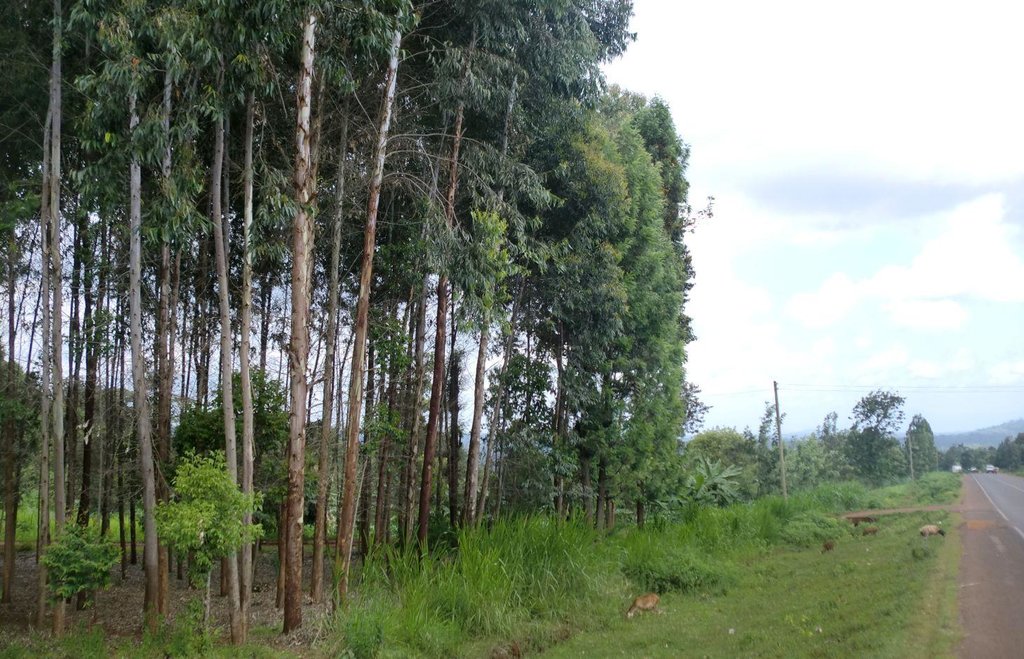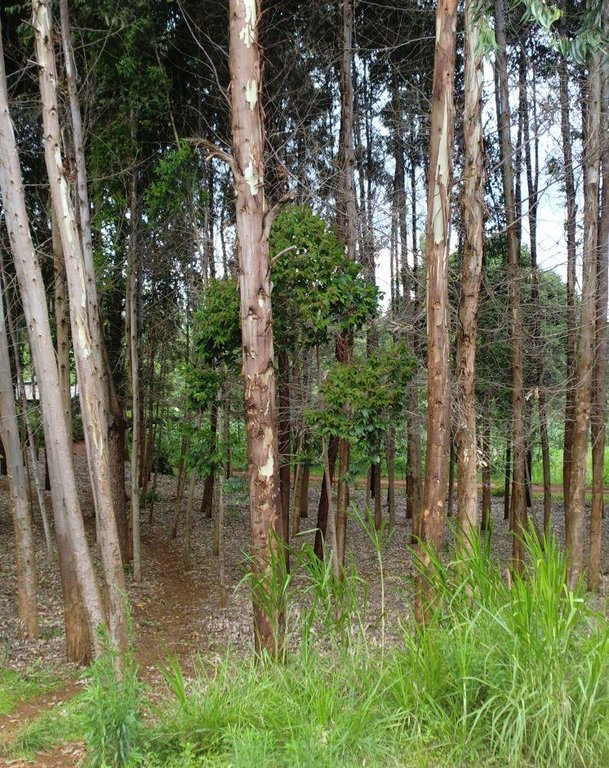Woodlot [Kenya]
- Creation:
- Update:
- Compiler: Paul Kahiga
- Editor: –
- Reviewer: Fabian Ottiger
Mutitu (Kiembu and Mbeere)
technologies_1736 - Kenya
View sections
Expand all Collapse all1. General information
1.2 Contact details of resource persons and institutions involved in the assessment and documentation of the Technology
SLM specialist:
Gathenya John
Jomo Kenyatta University of Agriculture and Technology
P.O.Box, 62000-00200, Nairobi, Juja, Kenya
Kenya
SLM specialist:
Home Patrick
Jomo Kenyatta University of Agriculture and Technology
P.O.Box, 62000-00200, Nairobi, Juja, Kenya
Kenya
SLM specialist:
Wamuongo Jane
+254 729 054547
Kenya Agricultural Research Institute
Nairobi
Kenya
Name of the institution(s) which facilitated the documentation/ evaluation of the Technology (if relevant)
KARI Headquarters (KARI Headquarters) - KenyaName of the institution(s) which facilitated the documentation/ evaluation of the Technology (if relevant)
Jomo Kenyatta University (Jomo Kenyatta University) - Kenya1.3 Conditions regarding the use of data documented through WOCAT
When were the data compiled (in the field)?
06/03/2012
The compiler and key resource person(s) accept the conditions regarding the use of data documented through WOCAT:
Yes
1.4 Declaration on sustainability of the described Technology
Is the Technology described here problematic with regard to land degradation, so that it cannot be declared a sustainable land management technology?
No
2. Description of the SLM Technology
2.1 Short description of the Technology
Definition of the Technology:
This is a vegetative technology that involves planting of trees in a portion of land for various uses.
2.2 Detailed description of the Technology
Description:
Woodlots in both Embu and Mbeere districts and in most parts of rural Kenya are usually small afforested plots of 0.04 to 0.5ha which are usually associated with the local demand for timber and fuel wood. They are mainly established and managed on individual basis. Grevillea Robusta and Eucalyptus trees are the main tree species used for woodlots in Embu District. Fast-growing and coppicing species are best for woodlot establishment.
Purpose of the Technology: Woodlots are mainly used for provision of firewood, timber and building materials. Woodlots also prevent soil erosion through their thick mulch and roots that hold the soil together. Other benefits of woodlots includes provision of cool weather, air purification or windbreakers. They are well protected, especially during the first years after establishment.
Establishment / maintenance activities and inputs: Farmers in Embu district normally obtain healthy plants is by using seedlings from their individual or local nurseries. The nurseries should be set 6-10 weeks before the start of the rainy season. The plants must be transferred to the fields in the early rainy season. The trees can be planted after a shallow ploughing (seeds) or in planting pits (seedlings). Spacing changes according to the purpose, 2 x 2 m or 2 x 4 m are common options. Management should be particularly careful in the first years. Weeding should be carried out 2-3 times in the first 2 years in order to avoid competition with weeds and reduce pests’ infestations. The area must be closed to grazing animals for the first few
years. Woodlots need protection from fire.
Natural / human environment: At early stages of establishment, farmers inter-crop the trees with crops. Percieved poor land that cannot be used for anything but trees is primarily recommended for woodlots. While siting the location of planting woodlot, transport requirements must be borne in mind. The site for timber and wood production for domestic use should preferably be near the house to reduce the burden of carrying firewood
2.3 Photos of the Technology
2.5 Country/ region/ locations where the Technology has been applied and which are covered by this assessment
Country:
Kenya
Region/ State/ Province:
Eastern Province
Further specification of location:
Embu District
2.6 Date of implementation
If precise year is not known, indicate approximate date:
- 10-50 years ago
2.7 Introduction of the Technology
Specify how the Technology was introduced:
- through land users' innovation
3. Classification of the SLM Technology
3.1 Main purpose(s) of the Technology
- improve production
- reduce, prevent, restore land degradation
- create beneficial economic impact
3.2 Current land use type(s) where the Technology is applied

Cropland
- Annual cropping
- Tree and shrub cropping
Main crops (cash and food crops):
Major cash crop: Coffee
Major food crop: Maize

Forest/ woodlands
(Semi-)natural forests/ woodlands:
- Selective felling
Products and services:
- Timber
- Fuelwood
Comments:
Major land use problems (compiler’s opinion): Soil erosion
Major land use problems (land users’ perception): firewood
3.3 Further information about land use
Water supply for the land on which the Technology is applied:
- rainfed
Specify:
Longest growing period in days: 1500, Longest growing period from month to month: five years
3.4 SLM group to which the Technology belongs
- natural and semi-natural forest management
- windbreak/ shelterbelt
- improved ground/ vegetation cover
3.5 Spread of the Technology
Specify the spread of the Technology:
- evenly spread over an area
If the Technology is evenly spread over an area, indicate approximate area covered:
- < 0.1 km2 (10 ha)
Comments:
Woodlots in thie Embu North District are implemented on small individual farms
3.6 SLM measures comprising the Technology

vegetative measures
- V1: Tree and shrub cover
Comments:
Type of vegetative measures: aligned: -contour
3.7 Main types of land degradation addressed by the Technology

biological degradation
- Bc: reduction of vegetation cover
Comments:
Main causes of degradation: deforestation / removal of natural vegetation (incl. forest fires), population pressure
3.8 Prevention, reduction, or restoration of land degradation
Specify the goal of the Technology with regard to land degradation:
- prevent land degradation
4. Technical specifications, implementation activities, inputs, and costs
4.1 Technical drawing of the Technology
Author:
Paul Kahiga, 62000-00200 Nairobi
4.2 Technical specifications/ explanations of technical drawing
The technical drawing on the left shows a stand of woodlot with natural vegetation growing underneath. The woodlot mainly comprises of Eucalyptus and Grevillea Robusta trees for fire wood and timber production.
Location: Embu North District. Eastern province
Date: 02.09.2011
Technical knowledge required for land users: moderate
Main technical functions: stabilisation of soil (eg by tree roots against land slides)
Secondary technical functions: control of raindrop splash, improvement of ground cover
Aligned: -contour
Vegetative material: T : trees / shrubs
Number of plants per (ha): 500
Vertical interval between rows / strips / blocks (m): 2
Spacing between rows / strips / blocks (m): 2
Vertical interval within rows / strips / blocks (m): 2
Width within rows / strips / blocks (m): 2
In blocks
Vegetative material: T : trees / shrubs
4.3 General information regarding the calculation of inputs and costs
other/ national currency (specify):
Kshs
Indicate exchange rate from USD to local currency (if relevant): 1 USD =:
100.0
Indicate average wage cost of hired labour per day:
4.00
4.4 Establishment activities
| Activity | Type of measure | Timing | |
|---|---|---|---|
| 1. | Seeding | Vegetative | before the rainy season |
| 2. | Transplanting | Vegetative | Onset of the rainy season |
4.5 Costs and inputs needed for establishment
| Specify input | Unit | Quantity | Costs per Unit | Total costs per input | % of costs borne by land users | |
|---|---|---|---|---|---|---|
| Labour | Transplanting | Mandays | 4.0 | 1.0 | 4.0 | 100.0 |
| Equipment | Tools | ha | 1.0 | 5.0 | 5.0 | 100.0 |
| Plant material | Seeds | Grams | 100.0 | 0.05 | 5.0 | 100.0 |
| Total costs for establishment of the Technology | 14.0 | |||||
Comments:
Duration of establishment phase: 2 month(s)
4.6 Maintenance/ recurrent activities
| Activity | Type of measure | Timing/ frequency | |
|---|---|---|---|
| 1. | Weeding | Vegetative | 2-3 times for the first three years |
| 2. | Prunning | Vegetative | once per year |
4.7 Costs and inputs needed for maintenance/ recurrent activities (per year)
| Specify input | Unit | Quantity | Costs per Unit | Total costs per input | % of costs borne by land users | |
|---|---|---|---|---|---|---|
| Labour | Weeding | mandays | 10.0 | 0.4 | 4.0 | 100.0 |
| Labour | Prunning | mandays | 10.0 | 0.4 | 4.0 | 100.0 |
| Equipment | Tools | ha | 1.0 | 5.0 | 5.0 | 100.0 |
| Total costs for maintenance of the Technology | 13.0 | |||||
4.8 Most important factors affecting the costs
Describe the most determinate factors affecting the costs:
Labor and the cost of seedlings are the most determinate factors affecting the costs.
5. Natural and human environment
5.1 Climate
Annual rainfall
- < 250 mm
- 251-500 mm
- 501-750 mm
- 751-1,000 mm
- 1,001-1,500 mm
- 1,501-2,000 mm
- 2,001-3,000 mm
- 3,001-4,000 mm
- > 4,000 mm
Agro-climatic zone
- humid
- sub-humid
Thermal climate class: tropics
5.2 Topography
Slopes on average:
- flat (0-2%)
- gentle (3-5%)
- moderate (6-10%)
- rolling (11-15%)
- hilly (16-30%)
- steep (31-60%)
- very steep (>60%)
Landforms:
- plateau/plains
- ridges
- mountain slopes
- hill slopes
- footslopes
- valley floors
Altitudinal zone:
- 0-100 m a.s.l.
- 101-500 m a.s.l.
- 501-1,000 m a.s.l.
- 1,001-1,500 m a.s.l.
- 1,501-2,000 m a.s.l.
- 2,001-2,500 m a.s.l.
- 2,501-3,000 m a.s.l.
- 3,001-4,000 m a.s.l.
- > 4,000 m a.s.l.
5.3 Soils
Soil depth on average:
- very shallow (0-20 cm)
- shallow (21-50 cm)
- moderately deep (51-80 cm)
- deep (81-120 cm)
- very deep (> 120 cm)
Soil texture (topsoil):
- medium (loamy, silty)
Topsoil organic matter:
- medium (1-3%)
If available, attach full soil description or specify the available information, e.g. soil type, soil PH/ acidity, Cation Exchange Capacity, nitrogen, salinity etc.
Soil fertility: Medium
Soil drainage/infiltration: Good
Soil water storage capacity: Medium
5.4 Water availability and quality
Ground water table:
5-50 m
Availability of surface water:
good
Water quality (untreated):
good drinking water
5.5 Biodiversity
Species diversity:
- medium
5.6 Characteristics of land users applying the Technology
Market orientation of production system:
- mixed (subsistence/ commercial
Off-farm income:
- less than 10% of all income
Relative level of wealth:
- average
Individuals or groups:
- individual/ household
Level of mechanization:
- manual work
Gender:
- women
- men
Indicate other relevant characteristics of the land users:
Land users applying the Technology are mainly common / average land users
Population density: 10-50 persons/km2
Annual population growth: 0.5% - 1%
5.7 Average area of land owned or leased by land users applying the Technology
- < 0.5 ha
- 0.5-1 ha
- 1-2 ha
- 2-5 ha
- 5-15 ha
- 15-50 ha
- 50-100 ha
- 100-500 ha
- 500-1,000 ha
- 1,000-10,000 ha
- > 10,000 ha
Is this considered small-, medium- or large-scale (referring to local context)?
- small-scale
5.8 Land ownership, land use rights, and water use rights
Land ownership:
- individual, titled
Land use rights:
- individual
Water use rights:
- individual
5.9 Access to services and infrastructure
health:
- poor
- moderate
- good
education:
- poor
- moderate
- good
6. Impacts and concluding statements
6.1 On-site impacts the Technology has shown
Socio-economic impacts
Production
crop production
fodder production
wood production
product diversity
Income and costs
farm income
Socio-cultural impacts
food security/ self-sufficiency
Improved livelihoods and human well-being
Comments/ specify:
Fire wood and timber is used for building houses
Ecological impacts
Water cycle/ runoff
surface runoff
groundwater table/ aquifer
Climate and disaster risk reduction
wind velocity
6.2 Off-site impacts the Technology has shown
wind transported sediments
6.4 Cost-benefit analysis
How do the benefits compare with the establishment costs (from land users’ perspective)?
Short-term returns:
positive
Long-term returns:
positive
How do the benefits compare with the maintenance/ recurrent costs (from land users' perspective)?
Short-term returns:
positive
Long-term returns:
positive
6.5 Adoption of the Technology
Of all those who have adopted the Technology, how many have did so spontaneously, i.e. without receiving any material incentives/ payments?
- 90-100%
Comments:
100% of land user families have adopted the Technology without any external material support
There is a moderate trend towards spontaneous adoption of the Technology
6.7 Strengths/ advantages/ opportunities of the Technology
| Strengths/ advantages/ opportunities in the compiler’s or other key resource person’s view |
|---|
| Production of timber and firewood. |
| Woodlots acts as windbreaks |
6.8 Weaknesses/ disadvantages/ risks of the Technology and ways of overcoming them
| Weaknesses/ disadvantages/ risks in the compiler’s or other key resource person’s view | How can they be overcome? |
|---|---|
| Occupies land that could otherwise be utilized for food crops | Plant the trees along the boundaries. |
7. References and links
7.1 Methods/ sources of information
- field visits, field surveys
- interviews with land users
Links and modules
Expand all Collapse allLinks
No links
Modules
No modules




